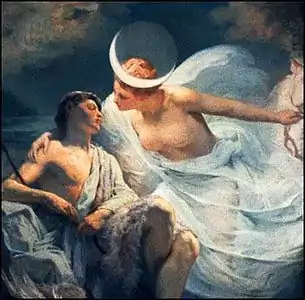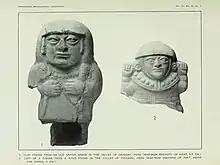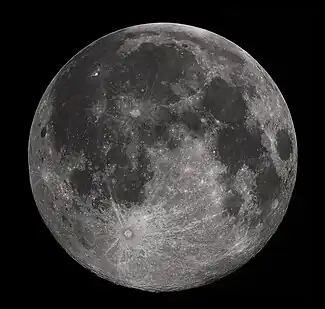Lunar deity
A lunar deity or moon deity is a deity who represents the Moon, or an aspect of it. These deities can have a variety of functions and traditions depending upon the culture, but they are often related. Lunar deities and Moon worship can be found throughout most of recorded history in various forms.

| Part of a series on |
| Anthropology of religion |
|---|
 |
| Social and cultural anthropology |
Moon in religion and mythology
Many cultures have implicitly linked the 29.5-day lunar cycle to women's menstrual cycles, as evident in the shared linguistic roots of "menstruation" and "moon" words in multiple language families.[1] This identification was not universal, as demonstrated by the fact that not all moon deities are female. Still, many well-known mythologies feature moon goddesses, including the Greek goddess Selene, the Roman goddess Luna, and the Chinese goddess Chang'e. Several goddesses including Artemis, Hecate, and Isis did not originally have lunar aspects, and only acquired them late in antiquity due to syncretism with the de facto Greco-Roman lunar deity Selene/Luna.[2][3] In traditions with male gods, there is little evidence of such syncretism.
Male lunar gods are also common, such as Sin of the Mesopotamians, Mani of the Germanic tribes, Tsukuyomi of the Japanese, Igaluk/Alignak of the Inuit, and the Hindu god Chandra. The original Proto-Indo-European lunar deity, *Meh₁not appears to have been male, with many possible derivatives including the Homeric figure of Menelaus. Cultures with male moon gods often feature sun goddesses and vice versa. In Bakongo religion, the earth and moon goddess Nzambici is the female counterpart of the sun god Nzambi Mpungu.[4] An exception is Hinduism, featuring both male and female aspects of the solar divine. The ancient Egyptians had several moon gods including Khonsu and Thoth, although Thoth is a considerably more complex deity.[5] Set represented the moon in the Egyptian Calendar of Lucky and Unlucky Days.[6]
Metztli, Coyolxauhqui and Tēcciztēcatl are all lunar deities in the Aztec religion.
.jpg.webp)
Many cultures are oriented chronologically by the Moon, as opposed to the Sun. The Hindu calendar maintains the integrity of the lunar month and the moon god Chandra has religious significance during many Hindu festivals (e.g. Karwa Chauth, Sankashti Chaturthi, and during eclipses).[7] The ancient Germanic tribes were also known to have a lunar calendar.
The Moon features prominently in art and literature, often with a purported influence on human affairs.
References
- Harding, Esther M., 'Woman's Mysteries: Ancient and Modern', London: Rider, 1971, p. 24.
- Adler, Margot (1986). Drawing Down the Moon: Witches, Druids, Goddess-Worshippers, and Other Pagans in America Today, Revised and Expanded Edition. Beacon Press. ISBN 978-0-8070-3253-4.
- Sfameni Gasparro, Giulia (2007). "The Hellenistic Face of Isis: Cosmic and Saviour Goddess". In Bricault, Laurent; Versluys, Miguel John; Meyboom, Paul G. P. (eds.). Nile into Tiber: Egypt in the Roman World. Proceedings of the IIIrd International Conference of Isis Studies, Faculty of Archaeology, Leiden University, May 11–14 2005. Brill. pp. 40–72. ISBN 978-90-04-15420-9.
- Scheub, Harold (2000). A Dictionary of African Mythology: The Mythmaker as Storyteller (1st ed.). Oxford University Press. pp. 92, 93, 114, 115. ISBN 9780195124569.
- Thoth, the Hermes of Egypt: a study of some aspects of theological thought in ancient Egypt, page 75
- Jetsu, L.; Porceddu, S. (2015). "Shifting Milestones of Natural Sciences: The Ancient Egyptian Discovery of Algol's Period Confirmed". PLOS ONE. 10 (12): e.0144140 (23pp). arXiv:1601.06990. Bibcode:2015PLoSO..1044140J. doi:10.1371/journal.pone.0144140. PMC 4683080. PMID 26679699.
- Christopher John Fuller (2004). The Camphor Flame: Popular Hinduism and Society in India. Princeton University Press. pp. 109–110. ISBN 978-0-69112-04-85.
